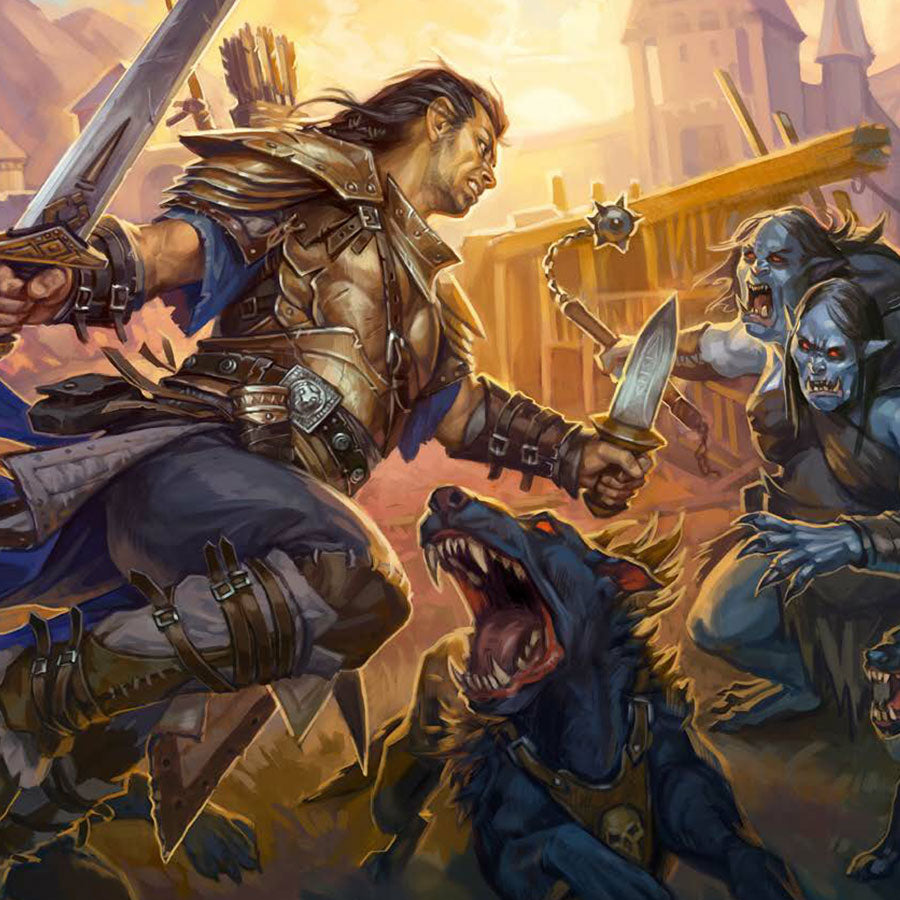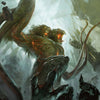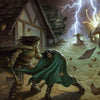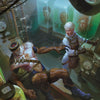Seven Strategies for Adjusting D&D Encounters on the Fly

Recently my six players confronted a pair of shambling mounds, and according to the difficulty calculator it was a moderate encounter, and they should have been okay. SHOULD HAVE. However, on the very first round of combat, and certainly by the second, it had become very clear that if things proceeded as they were, we were looking at a TPK. And not one of those TPKs where there is this dramatic back and forth as both sides vie for dominance, but one of those short-lived TPKs where the players never stand a chance.
So, I was faced with the classic dungeon master dilemma. Do I use my unlimited power to intercede, or do I play it as it lies and let things work themselves out naturally?
Now this dilemma that DMs often face in their D&D games leads us to consider the things that game masters should never do in their encounters. (And, yes, we’ll talk about what happened with those shambling mounds, too.)
However, we’re also going to discuss how a game master SHOULD and CAN adjust an encounter on the fly during combat if things are looking easier or harder than intended.
By the way, if you’re a new dungeon master feeling a bit OVERWHELMED by everything involved in running a D&D game, I completely understand. Being a DM isn’t always easy, and my personal goal is to help game masters by providing information and resources to make your life easier! That’s why my team and I make all these articles and videos.
However, Lairs & Legends is another such resource. With over 700 pages of adventures, monsters, puzzles, traps, and other 5e GM resources, you can SIGNIFICANTLY reduce your prep time and still run amazing games for your players.
Watch or listen to this article by clicking the video below.
Part 1: What Not to Do
#1 Never Blunder Forward Mindlessly
When you find yourself in this situation—or the opposite where an encounter is way easier than you intended—you should stop to think. Never just shrug and keep going. And what should you consider? What are the consequences of continuing the encounter as-is? If it’ll just be a bit easier than you thought and it’s only a random encounter, then maybe it’s not a big deal. But if it’s the boss fight of an adventure—or the final confrontation against the Big Bad at the end of a campaign—and it’s turning out to be too easy, well then maybe you should intercede and beef things up. Why? Well, because it can be an anticlimactic letdown to players when the Big Bad just drops dead in the first round. I’ve had this happen before, and I hate disappointing players in that way.
In the case of the fight being too hard, if it’s clearly looking like it might be a TPK—such as in my shambling mound example—that requires some serious consideration. Now, I don’t think there is a right and wrong answer here—there rarely is in tabletop RPGs—but I’ll tell you my basic approach. If the encounter is an important one, such as a boss fight, and I designed it to be challenging, I’ll often play it as-is, without making it easier on the fly. However, if it’s just a random encounter or a mook fight in the dungeon, and it wasn’t SUPPOSED to be so challenging, and certainly not at a TPK level of challenge, then I will often step in to make it easier. Now if something is just harder than I thought, but I don’t think the PC lives are in danger, I’ll often just let it go on as planned.
The basic line of thought I use in any circumstance is generally the same: how grave are the consequences of doing nothing? If they aren’t that bad, I usually do nothing. I play the encounter as-is without any adjustments. On the other hand, if the consequences of doing nothing are grave indeed, then I consider carefully my next step. I may adjust or I may not, but I definitely think good and long about it.
#2 Never Fear
Look, it’s okay if an encounter is harder or easier than you planned. It’s impossible to get the difficulty just right; there are just so many variables in the game. It doesn’t matter if you’re playing D&D 5e which is known for having a broken challenge rating system, or if you’re playing a system like Pathfinder 2e which has much tighter math. You WILL have variability in your encounters; some will be easier than you thought, others harder. That’s life; accept it; and worry less. BTW, for what it’s worth in my example with the shambling mounds, that was actually a Pathfinder 2 game, and the creatures were called “shamblers” for copyright reasons I suppose. And my group was at level 4. The difficulty calculator SAID moderate, but holy crap, the shamblers were toasting them. They have this Vine Lash ability that lets them hit EVERYONE within reach, and it was absolutely nasty.
And remember, it’s okay if your characters lose. It’s okay if a few PCs die. It’s okay if the entire group TPKs. I know that PC defeat and death is more and more becoming a stigma and something that folks think should NEVER happen. However, for me personally, if there is no possibility of defeat and death in the game, then it’s not worth playing. Your mileage may vary, and I’ll never say you’re playing the game “wrong”, but I do think when death and defeat are taken off the table everyone misses out on a fair bit of excitement and suspense that makes the game so much better.
#3 Never Fudge Dice
I’ve been on the record multiple times that fudging dice during an encounter is the lazy dungeon master’s way of adjusting an encounter. I think there are far better and more interesting ways to adjust an encounter on a fly if you’ve decided to do so—and, yes, we’ll talk about those in just a little bit. However, while fudging dice is a lever you can pull to tweak things, I personally find it unsatisfying. I don’t think there is anything inherently WRONG with it, though. I mean, if you’ve already decided to change the difficulty of an encounter on the fly, you’re already changing it, so what difference does it really make HOW you change it? Technically it doesn’t, but I think EXPERIENTIALLY it does.
#4 Never Use an NPC Rescuer
When my players where taking on those shambling mounds, they had been sent there by a group of myconids who were nearby. It would have been quite easy for me to simply have a few myconids join the battle to help the characters once I noticed things going south, and that would have solved everything, right? What’s more, the myconids had healing spores they could have used to bring up characters who had dropped to zero hit points.
Now, on this point I shall remain very dogmatic. I strongly believe that having a NPC rescuer swoop in to save the players’ bacon is deeply unsatisfying on so many levels. First, it’ obvious what you’re doing. There is no subterfuge; no suspension of disbelief: it’s clear to your players that you’re rescuing them from certain doom.
Second, it remove the spotlight from the characters’ and what they accomplish and how awesome they are, and shifts it to the NPC rescuers. This is the equivalence of Gandolf conveniently returning to help the hobbits at critical moments. The hobbits only feel that much smaller and insignificant. There is no clutch win when things seem most grime; there is no celebration when they avoid certain doom. No, there is only the sinking recognition that you were screwed and your dungeon master decided to save your bacon—and in a degrading way, I might add.
#5 Never Admit to Your Players What You Did
Now players aren’t stupid. Sometimes no matter which method you use to adjust an encounter on the fly, they’ll noticed. And they will especially notice if they are long-time players or dungeon masters themselves.
However, my advice to you is to NOT tell them what you did. Do NOT after the battle be like, yeah that was crazy hard, and I had to do this that and the other to adjust it for you. That accomplishes everything you DON’T want: it can make your players feel small, insignificant, and incapable. It removes all semblance of agency and meaningful choices because you are essentially telling them that their decisions and actions were meaningless; they only survived because of YOUR good graces.
No, don’t do this. As much as possible you want your players to BELIEVE that they survived because of their own efforts, luck, dice rolls, and other factors. You do not want them to know it was you behind the screen pulling strings for them. And, by the way, this is the principal reason that I adjust encounters on the fly as little as possible in my games. My strong preference is to play them as-is.
Part 2: What You Should Do
Okay, now let’s say you’ve decided to adjust an encounter, just like I decided to do so in my shambling mound battle—how SHOULD you do that? Here are seven basic methods you can use.
#1 Adjust Hit Points
Now, if a battle is TOO HARD, reducing the hit points of monsters is a quick way to make it easier. The monsters suddenly turn into glass cannons, things seem deperate at first as they dish out damage, but then they start dropping and your players sigh in relieve and spirits and excitement rise. Of course, players might look up the stats afterwards and see that they “should have” had more hit points. However, I often tell my players that I homebrew monsters to give me a smoke screen in this regard.
However, if the fight is TOO EASY, increasing hit points is usually NOT my preferred method. Monsters that live longer just make a battle longer, and battles in some systems such as D&D already take a long time. I don’t want them to take longer. Instead, I’d much rather increase DAMAGE to make the monsters more dangerous; that way the combat doesn’t take longer. However, I will say I have had some BOSS FIGHTS where I’ve increased hit points BECAUSE the boss was going to drop in one round. So, doing so is not taboo, but if you are going to increase hit points, I’d only do it if the monster is going to drop in the first round or so. A three round combat is a good goal to aim for when doing this.
#2 Spread Attacks Over Multiple PCs or Focus Fire
This is a simple one. If a fight is too hard, you can make it easier by having your monsters spread their attacks over multiple characters. Since a PC fights at 100% capacity even when they only have 1 hit point remaining, this works very well. What makes this tricky is the transition from only attacking one PC to starting to spread attacks, because it can be obvious to players that you’re doing this. Remember, we’re trying to adjust in ways that are more difficult for players to notice.
On the other hand, when a fight is too easy, and monsters begin to focus on just one character—the one that has proven to be the most dangerous—that’s far less obvious. In fact, it’s NORMAL for enemies to concentrate on the most dangerous of their foes. Now, doing this might not make the encounter more challenging overall, but it will make it more DANGEROUS for the character being targeting, AND more than that, it changes the dynamics of the battle. It’s no longer a question of just betting the monsters; it’s a question of beating them BEFORE they murderize one of our companions.
#3 Change Monster Tactics
When the shambling mounds were using their crazy Vine Lash ability and hitting all characters nearby, usually three at a time, this is the route I chose. Once characters were dropping and things looked bleak, the shambling mounds decided to just drag a couple characters away for consumption. From a roleplaying perspective this made sense. The shambling mounds are motivated by hunger. If they can demonstrate their power, give everyone a sound beating, and then drag a couple off for a meal, they believe the others will probably flee and leave them to their supper. I mean, it’s worked before for them, after all.
However, from a game mechanic standpoint it did three things. First, it make the monster begin to use less damaging attacks and tactics, and second, it allowed the other characters to recover a bit and formulate a plan. The third thing it did was change the DYNAMICS of the encounter. Instead of trying to figure how how to just not die, the characters then began to think of how to rescue their two friends being dragged off.
I’ve mentioned this before, but changing encounter dynamics is a powerful tool, not just for adjusting an encounter, but for making encounters more INTERESTING. Your players settle into a rhythm for rounds one and two maybe, but then there is a CHANGE in circumstances, and they need to reformulate plans and tactics. You see this technique all the time in movies and novels. Static is boring; dynamic and changing circumstances are much more exciting and dramatic.
#4 Adjust Special Abilities and Spells and Other Stats
Something else that I could have done for the shambling mounds was make it so that their Vine Lash had a cooldown and could only be used once every three rounds say. That would have made them come out of the gate with crazy damage to freak everyone out, and then the DPS decreased making things much more doable.
The basic approach is when things are TOO HARD you limit special abilities; when things are TOO EASY you increase their usage. Who’s to say that a dragon can only breathe fire every four rounds? Maybe THIS DRAGON can do it every other round…or every round. If you’re running a spellcaster, and its first fireball practically kills the entire group, just don’t use the next two fireballs, and he starts using 2nd level and 1st level spells. The players don’t know how many spell slots he has! Or if the fireball barely scratches them, perhaps the wizard decides to cast chain lightning or finger of death on the next round. I mean, the wizard might not know how touch the characters are, and when he sees them take a fireball without flinching, he decides to up the ante.
You can even adjust other stats such as armor class or damage output. The big trick here is that you don’t want your adjustment to be obvious to your players. What I like to do is justify the adjustment through roleplaying and/or narrative description. “Your blow appears to have damaged their armor for some reason. Perhaps it was poorly made.” Or “Now that you’ve lightly wounded your foe, you see anger seeing in its eyes, and it flies into a rage, attacking more viciously than before.”
#5 Use Waves
This is a tried-and-true method for increasing difficulty that is practically impossible for players to detect. The first band of kobolds may be dropping like flies, but the players have no idea that the SECOND band of kobolds that bursts through the door to the room never technically existed and that you just made it up.
And conversely, you can use waves to give you FLEXIBILITY just in case you aren’t sure if something may be too hard or not. You simply design the encounter with waves, and then if the challenge feels about right, you just don’t have the subsequent waves arrive. But, if it’s too easy, the waves do arrive. And you can adjust WHEN they arrive, too. Perhaps in round two, but maybe not round three. This is a great strategy if your perhaps just learning a new game system and don’t feel comfortable yet with nailing the challenge just right or with other ways of adjusting on the fly.
Using waves also hits on that DYNAMIC element we mentioned earlier. So, all round, waves are an EXCELLENT way to go. My only word of caution is that you shouldn’t use waves TOO MUCH as anything in excess can become overused and boring. Variety is king.
#6 Monsters Flee
In the same game session as the shambling mounds, my players also confronted this massive, hideous giant. Now, it was INTENDED to only be a social interaction, but one of my players decided to attack, perhaps a little prematurely, but it’s all good. And wouldn’t you know it, this battle turned out to be brutal, too. So, after the second round, when the giant had taken about half its hit points in damage, I decided to have it retreat, tears bubbling in its eyes, and then it ran off calling for its mama.
Now, morale checks are a mechanic that exists in many game systems, and you can certainly use them if you wish. I personally, though, usually just ROLEPLAY my monsters in this regard instead of relying on game mechanics. And in the case of an encounter that is too challenging, I can simply DECIDE to have monsters retreat, much like I did with that giant. And I must say, one of my players proclaimed afterwords that if THAT giant was just the child, he was HORRIFIED at what the mama would have been. So, naturally, my players got out of dodge posthaste. LOL
By the way, if you’d like to watch the game session where all this took place, check out episode 15 of my Thieves Abound Pathfinder 2 campaign.
#7 Allow Crazy Ideas to Work
In moments of desperation, players will often come up with the craziest of ideas. My suggestion to you is to be more receptive to those crazy ideas, and be more receptive to them working. Now, players often have crazy ideas, and under normal circumstances, they might not work. But when a TPK is looming, that’s the precise moment to be more open-minded. What’s more, if their crazy idea does work—assuming decent dice rolls and whatnot—they will attribute their success to THEMSELVES and not you interceding on their behalf, and that’s EXACTLY what you want.
Being a Dungeon Master Shouldn’t Be an Exercise in Frustration!
When I was a new dungeon master, I was overwhelmed with everything I needed to do. Learn the rules, create the adventures, run the game, handle problem players—it was A LOT! And even as a veteran DM, it’s still a lot. You might even feel that way yourself.
This is exactly why my team and I dedicate our time to producing resources to help our fellow dungeon masters: we know exactly how you sometimes feel!
Now, if you’re stressed out with having to create all the adventures for your 5e game, or you’re looking for elements such as traps, puzzles, and encounters that you can drag and drop into your game, we have you covered. With Lairs & Legends and Loot & Lore, you’ll get over 700 pages of 5e resources:
- Twenty-nine 5e adventures spanning levels 1 to 15 and designed for groups of 4 to 6 players.
- Over 100 new creatures from CR 0 to CR 24.
- Adventure Ideas
- Encounters with Full-Color and Blackline Digital Maps
- Patrons & Factions
- Magic Items
- NPCs
- Puzzles
- Random Encounter Tables
- Random Tables
- Spells
- Subclasses
- Traps
- Villains
Everything is designed to be EASY TO USE and QUICK TO PREP for your game. Our goal is to make game masters’ lives easier, not more complex!
Don’t spend another moment frustrated and overwhelmed as a DM. Pick up the Lairs & Legends Ultimate Bundle today and find out how much easier being a DM can be!
-
Posted in
Game Master How-To Articles







